NRAO eNews
Volume 3, Issue 12 • December 8, 2010
Upcoming Events

 NRAO Town Hall - 217th AAS Meeting
NRAO Town Hall - 217th AAS Meeting
January 11, 2011 | 6:30 PM | Seattle, WA | Ballroom 6E
 Early Science with the EVLA - Special Session - 217th AAS Meeting
Early Science with the EVLA - Special Session - 217th AAS Meeting
January 12, 2011 | 10:00 AM | Seattle, WA | Room 611/612
 Observing with ALMA - Special Session- 217th AAS Meeting
Observing with ALMA - Special Session- 217th AAS Meeting
January 12, 2011 | 2:00 PM | Seattle, WA | Ballroom 6A
 ALMA Early Science Proposal Preparation Tutorial
ALMA Early Science Proposal Preparation Tutorial
January 12, 2011 | 5:30 PM | Seattle, WA | Room 304
 ALMA: Extending the Limits of Astrophysical Spectroscopy
ALMA: Extending the Limits of Astrophysical Spectroscopy
January 15–17, 2011 | Victoria, British Columbia
 Hands-on ALMA Tutorial
Hands-on ALMA Tutorial
January 18, 2011 | Victoria, British Columbia
 Building on New Worlds, New Horizons
Building on New Worlds, New Horizons
March 7–10, 2011 | Santa Fe, NM
ALMA Early Science & NAASC Community Training Events

The ALMA Board, at its meeting on November 16-18, 2010 enthusiastically endorsed the progress of the ALMA project and announced that the first Call for Proposals is expected by the end of the first quarter of 2011. They noted that "ALMA is on track to begin Early Science observations late in 2011, as planned. While many challenges remain, it is already clear that ALMA 'works' . It is anticipated that the ALMA Director will issue a Call for Proposals for Early Science in the first quarter of 2011. That announcement will provide more details of the expected timeline and capabilities to be offered." The full November 2010 ALMA Board announcement, including recent ALMA test data images, is available on-line.
To prepare the North American community to fully participate in the Early Science (ES) call, the North American ALMA Science Center (NAASC) will organize community outreach and training events each month leading up to the proposal deadline. The first of these events will be at the American Astronomical Society (AAS) meeting in January in Seattle (see article in last edition of NRAO eNews). Other upcoming community training events will include:
- January 18: Victoria, BC (following the conference "Extending the Limits of Astrophysical Spectroscopy" )
- February 24-25: Hands-on Tutorials at NRAO-Charlottesville
- March 11: Santa Fe, NM (following the conference "Building on New Worlds, New Horizons" )
- April 26-27: Hands-on Tutorials at NRAO-Charlottesville
- May 9-10: Hands-on Tutorials at NRAO-Charlottesville
- May 22-26: Boston, MA (218th AAS Meeting)
More information about these training workshops will be posted on this website under ALMA in the near future.
In addition to these events, the NAASC announces an opportunity for the NA community to organize local ALM A Community Day(s).
We invite community members to submit proposals to host an ALMA Community Day(s) event, a one to two day event organized and led by the proposers with a focus on the Early Science capabilities of ALMA, mm/ submm interferometry observing techniques, and the tools required to design ALMA observing programs and submit proposals. The proposal should not be longer than one page and must include the following information:
- A detailed scientific program that highlights ALMA ES capabilities.
- Two or three possible dates for the proposed event.
- The expected location, size of the audience, and advertisement plan.
The NAASC will support the event by providing staff to describe ALMA ES capabilities and NAASC community support programs, and lead brief demonstrations and/or tutorials on the ALMA ES user tools, including the ALMA Observing Tool for proposal generation and SIMdata in CASA for simulating observations. The proposal should include a description of the desired level of NAASC staff support, and time for these activities should be included in the proposed scientific program.
We expect to be able to support one Community Day(s) event per month starting in February. Interested members of the community should contact Kartik Sheth for further details. Proposals for the March-May period should be sent to the NAASC by February 1, 2011, and by January 15 for a February event.
Download our flyer if you would like to post information on these events in your department.
For more information about the NAASC or about observing with ALMA, visit science.nrao.edu/alma and submit any other questions via the NAASC/ALMA department of the NRAO helpdesk through my.nrao.edu.
ALMA Construction Status
Al Wootten
First Quarter of the Antennas
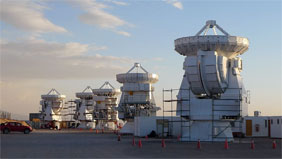
Figure 1: Five 7m antennas, assembled and awaiting testing, stare skyward in the Melco erection facility in northern Chile. Antenna CM01 (second from right) is now in advanced stages of testing. These antennas are the first of twelve that will eventually populate the Atacama Compact Array (ACA). Image from M. Norikazu courtesy ALMA (ESO/NAOJ/NRAO).
In the seven years since the November 2003 groundbreaking ceremony for the future Operations Support Facility (OSF), ALMA has progressed to the verge of its scientific career. This NRAO Newsletter includes an announcement from the ALMA Board enthusiastically endorsing the readiness of ALMA to begin Early Science observations in the latter part of 2011 as planned. The Joint ALMA Observatory (JAO) is working to ensure that at least sixteen antennas and associated infrastructure are prepared for this milestone.
During November, two additional antennas joined the ALMA complement at the 2900m-elevation OSF. These antennas are now undergoing outfitting and initial testing, and join the two already engaged in interferometric work at the OSF. Additional receiver packages are arriving in Chile from Front End Integration Facilities worldwide for incorporation into the new antennas; the eleventh was recently delivered. A priority for the two-element OSF interferometer is to complete antenna tests prior to moving to the 5000m-elevation Array Operations Site (AOS). An additional task is to test functionality of new software due for deployment in 2011 on the commissioning array. The new software release will enable functionality needed by scientists for their Early Science research. Details of the expected Early Science functionality are available on the North American ALMA Science Center (NAASC) website.
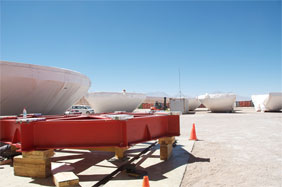
Figure 2: Antenna backup structures await assembly in the ESO/AEM contractor yard. These carbon fiber structures are shipped in halves that must be precisely glued together to form the support for the antenna panels.
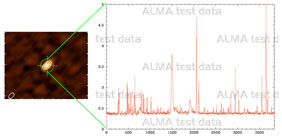
Figure 3: ALMA's broad spectroscopic reach provides it with great potential for spectroscopic surveys. (Left) A test data image of the hot molecular core G34.26+0.15, unresolved with the commissioning array. (Right) A single 1.875 GHz portion of the object's spectrum at λ 3mm, showing a crowded molecular line forest. Image courtesy ALMA (ESO/NAOJ/NRAO).
Elsewhere at the OSF, the contractors’ antenna erection facilities are assembling the antennas that will populate the Early Science Array. All four NAOJ/Melco antennas are moving towards incorporation into ALMA in the next few weeks. Five of the 7m Melco antennas now stand erect on the site (Figure 1). Five additional NRAO/Vertex 12m antennas are proceeding through assembly and tests in the Vertex yard, while a similar number are assembled in the ESO/AEM area. In the latter area, an antenna has begun its pointing and holography tests that are expected to soon lead to ALMA acceptance.
Eight antennas are conducting commissioning tests at the AOS, and they will be joined in a few weeks by a ninth antenna, which is expected to be located on a longer baseline than the 90m now available in the commissioning array. The ACA correlator, which is capable of handling up to sixteen antennas, recently underwent successful spectroscopic tests on the sky. The configurations of this correlator are matched with those of the 64-antenna correlator, one quadrant of which is under day-to-day use by the commissioning team. Two additional quadrants have been installed in the AOS Technical Building. As the reader is likely aware, ALMA can process four spectral regions of ~ 2 GHz bandwidth in both polarizations in a single observation. Figure 3 shows a test data example of the millimeter spectrum richness seen in a spectral survey observing mode trial. Readers are challenged to identify the particular spectral region illustrated.
In ALMA Construction personnel news, Wes Grammer has been appointed as North American System Engineering Integrated Project Team Lead, effective 21 November.
This Month @ the NAASC
Anthony Remijan and Lyndele von Schill
Did you know?
Are you interested in working at the North American ALMA Science Center (NAASC) or in Chile during ALMA commissioning? The NAASC and the Commissioning and Science Verification (CSV) team is looking for motivated post-docs to join the NAASC as ALMA ramps up to Early Science and eventually full science operations. For a complete description of these positions and information on how to apply, consult the Career Opportunities section of this issue of the NRAO eNews.
In addition, if you are interested in being interviewed for the post-doctoral position while attending the 2011 January AAS meeting in Seattle, please contact Scott Schnee at (sschnee@nrao.edu) prior to the start of the meeting.
Meet the NAASC
Two scientists have recently arrived at the NRAO and joined the North American ALMA Science Center (NAASC) user support team: Amy Kimball and Nuria Marecelino.
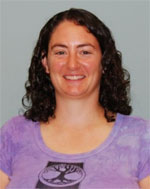 Amy Kimball joined the NRAO as a NAASC Post-doctoral Fellow on 13 September. Amy earned her PhD from the University of Washington earlier this year under the supervision of Dr. Željko Ivezić. She is experienced in analyzing data from large multi-wavelength sky surveys, including those performed using the NRAO/VLA and other radio interferometers. Amy's main research area is the study of radio quasars. She is particularly interested in exploring how quasar radio properties relate to their emission at other wavelengths, and understanding the causes of radio-jet production. Amy is excited about the opportunities ALMA will provide to study the inner regions of nearby quasars and their host galaxies.
Amy Kimball joined the NRAO as a NAASC Post-doctoral Fellow on 13 September. Amy earned her PhD from the University of Washington earlier this year under the supervision of Dr. Željko Ivezić. She is experienced in analyzing data from large multi-wavelength sky surveys, including those performed using the NRAO/VLA and other radio interferometers. Amy's main research area is the study of radio quasars. She is particularly interested in exploring how quasar radio properties relate to their emission at other wavelengths, and understanding the causes of radio-jet production. Amy is excited about the opportunities ALMA will provide to study the inner regions of nearby quasars and their host galaxies.
Amy will be working in support of the Joint ALMA Observatory (JAO), helping to process ALMA data and support ALMA users. She can be reached at akimball@nrao.edu.
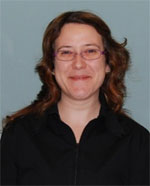 Nuria Marcelino arrived at the NRAO on 1 November to take up her position as a NAASC Post-doctoral Fellow. Nuria earned her PhD with Rainer Mauersberger (in Granada) and Jose Cernicharo (Madrid) at the Granada Institute for Millimeter Radio Astronomy (IRAM). She also worked as Astronomer-on-Duty at IRAM Granada's 30m telescope, assisting visiting astronomers and gaining experience in single dish observations. Before coming to NRAO, Nuria was a postdoc at the Laboratory for Molecular Astrophysics at the Center for Astrobiology Institution in Madrid, where she worked with Jose Cernicharo. Her research interests are astrochemistry in molecular clouds and star forming regions. She has performed spectral line surveys of different molecular clouds at millimeter wavelengths with the 30m telescope.
Nuria Marcelino arrived at the NRAO on 1 November to take up her position as a NAASC Post-doctoral Fellow. Nuria earned her PhD with Rainer Mauersberger (in Granada) and Jose Cernicharo (Madrid) at the Granada Institute for Millimeter Radio Astronomy (IRAM). She also worked as Astronomer-on-Duty at IRAM Granada's 30m telescope, assisting visiting astronomers and gaining experience in single dish observations. Before coming to NRAO, Nuria was a postdoc at the Laboratory for Molecular Astrophysics at the Center for Astrobiology Institution in Madrid, where she worked with Jose Cernicharo. Her research interests are astrochemistry in molecular clouds and star forming regions. She has performed spectral line surveys of different molecular clouds at millimeter wavelengths with the 30m telescope.
Nuria notes that “ALMA will be a powerful tool in the future of millimeter/sub-millimeter astronomy. I have experience with single-dish observations, but not in interferometric techniques. The NAASC seemed like the best place to go to gain this new experience. There are also a lot of people working here in different aspects of astronomical science, so I look forward to finding people to work with.”
Nuria will be working in support of the JAO, helping to evaluate data from ALMA, with the eventual goal of helping improve user documentation for ALMA data products, as well as other tasks. She can be reached at nmarceli@nrao.edu.
A New Release of the Common Astronomy Software Applications package
Juergen Ott, Jeff Kern, and the CASA Team
 We are pleased to announce a new release of the Common Astronomy Software Applications (CASA) package: release 3.1.0.
We are pleased to announce a new release of the Common Astronomy Software Applications (CASA) package: release 3.1.0.
The CASA package is being developed primarily by the NRAO, ESO, and NAOJ and will be used for the offline reduction and analysis of both ALMA and EVLA data. CASA is fully scriptable. Whereas full support is provided for ALMA, VLA, and EVLA formats, almost any data that can be written in uvfits format can be imported and reduced in CASA (for example: BIMA, CARMA, SMA, and ATCA data).
The Linux and Mac OS distributions of CASA 3.1.0 are now available from the CASA webpage. Please follow the links to "Obtaining CASA".
New features in CASA 3.1.0 include:
- increased flagging speed
- support for wideband deconvolution using Taylor terms
- flux calibration on Solar System objects
- multiple Gaussian and polynomial fitting of spectral lines
- new spectral line information tools
- scripting of image plots
- support for GBT SDFITS
- single dish flagmanager
- Mac OS 10.6 64bit support, and
- a new CASA logo!
A full list of all the new CASA features is available in the release notes.
26th New Mexico Symposium
Amy Mioduszewski
The 26th Annual New Mexico Symposium took place 5 November 2010 in Socorro, NM. The symposium is held every year in conjunction with the Jansky Prize Lecture, and is intended to support a network of scientific research in the southwestern United States.
The 2010 Symposium was held in the auditorium of the NRAO Domenici Science Operations Center in Socorro and was enjoyed by 114 registered participants from universities, observatories and research laboratories in and around New Mexico. The oral program consisted of 17 contributed talks and the invited Jansky Lecture by Prof. Reinhard Genzel (Max Planck Institute for Extraterrestrial Physics and UC-Berkley) titled "The Formation and Evolution of Massive Proto-disk Galaxies". There were also 23 contributed posters. The program spanned a wide breadth of topics from planet atmosphere simulations and observations of massive star forming regions to the Sunyaev-Zel'dovich effect in galaxy clusters and the physics of faster-than-light sources. More information on the program, including copies of most talks, is on-line.
The symposium was followed by a dinner and the public Jansky Lecture on the New Mexico Tech campus. Prof. Genzel gave a lecture titled "The Galactic Center Black Hole and Nuclear Star Cluster" that was very well received by symposium participants and members of the local community.
Recent Press Releases
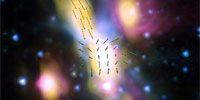 Surprise: Dwarf Galaxy Harbors Supermassive Black Hole
Surprise: Dwarf Galaxy Harbors Supermassive Black Hole
9 January 2011
Astronomers have found the first evidence of a magnetic field in a jet of material ejected from a young star, a discovery that points toward future breakthroughs in understanding the nature of all types of cosmic jets and of the role of magnetic fields in star formation. Read more...
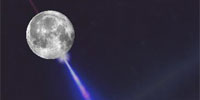 Students Excited by Stellar Discovery
Students Excited by Stellar Discovery
2 February 2011
Seeking to detect mysterious, ultra-high-energy neutrinos from distant regions of space, a team of astronomers used the Moon as part of an innovative telescope system for the search. Their work gave new insight on the possible origin of the elusive subatomic particles and points the way to opening a new view of the Universe in the future. Read more...
From the Archives
Ellen Bouton

About this month's photograph: The Children's Christmas Party in Charlottesville, 1972. Sandy Weinreb is on the left in the light suit, Cam Wade is on the left in the dark suit, Gerrit Verschuur is third from the right at the back. If readers are able to provide other identifications, please contact Ellen Bouton, ebouton@nrao.edu.
From the Archives is an ongoing series illustrating NRAO and U.S. radio astronomy history via images selected from our collections of individuals' and institutional papers. If readers have images they believe would be of interest to the Archives, please contact Ellen Bouton, ebouton@nrao.edu.
Career Opportunities
New Postings
Deputy Data Manager: ALMA is seeking a deputy manager for its Data Management Group in Chile. The successful candidate will manage daily activities of archive and pipeline operations; support data quality assurance work; and participate in testing, data delivery, planning, and archives setup.
System Integration Manager: ALMA is accepting applications for an integration manager who will be responsible for the overall management and technical leadership of the Assembly, Integration and Verification (AIV) process. The incumbent will manage the test and verification process, monitor the schedule of performance, manage the construction budget, and work with all levels within the division to ensure successful completion of the project.
ALMA System Astronomer: ALMA is recruiting a scientist to support the Commissioning and Science Verification team, and assist the Project Scientist in planning and executing the scientific commissioning of ALMA. Once ALMA is in full operation, the successful candidate will oversee data quality assurance, monitor long term performance, and manage various projects while also conducting their own astronomical research.
Scientist: The National Radio Astronomy Observatory is entering an extremely exciting phase driven by new science opportunities and new instrumentation. The Observatory is seeking scientific staff for instrumentalists, computational scientists, and observational scientists beginning September 2011 to be based at any of its U.S. facilities.
Tenure Track Astronomer: The NRAO invites applications for the position of Tenure Track Astronomer. Appointments will be made on the basis of both the candidate's excellence in research and their ability to maintain cutting-edge research programs and thereby further the mission of the Observatory.
NRAO Postdoc: The National Radio Astronomy in Green Bank, WV is seeking a postdoctoral fellow in the area of galaxy evolution. The position is aimed at studying the gas properties of LIRGs/ULIRGs in the local universe and at high redshift, and the successful candidate will work on the Green Bank Telescope (GBT), neutral hydrogen observations, data analysis, and follow-up observations.
Web Application/Database Developer: The National Radio Astronomy Observatory in Charlottesville, VA is seeking a Web Application/Database Developer. The successful candidate will be responsible for developing, testing, implementing, and supporting the public outreach website of the NRAO. He/she will work as part of a team of content and design/graphics specialists to develop a science and technology web site that includes web-based interactives, video products, and mobile device applications. The Web Application/Database Developer will also administer content management system and define and codify technical requirements for products specified by the team.
NRAO Postdoc: The National Radio Astronomy Observatory in Charlottesville, VA is seeking a NRAO Postdoc (NAASC Postdoctoral Fellow). This position is aimed primarily at independent research, with an emphasis on developing ALMA expertise and assisting the NAASC scientific staff in the support of ALMA users. ALMA-related activities may include: exercising ALMA end-user software from a scientific perspective, including the Observing Proposal and Submission tool, and the ALMA data reduction and analysis package CASA (Common Astronomy Software Applications); helping to develop ALMA tutorials and other user-outreach materials; and assisting visiting scientists with observation preparation and data reduction.
NRAO Postdoc: The National Radio Astronomy Observatory invites applications for the NRAO Postdoc (ALMA Commissioning Postdoc) position located in Santiago, Chile. The role of the ALMA Postdoctoral Fellow will be to assist the ALMA Commissioning Team in planning and executing the scientific commissioning of ALMA. As a member of the commissioning team, the successful applicant will work on preparing specific test procedures and trouble-shooting them, carrying out measurements, processing the data and producing reports. Assignments may include tasks such as measuring the properties of individual antennas, testing and calibrating the various interferometric observing modes, and moving on to verifying the quality of the scientific data that ALMA produces.

 Zoom
Zoom